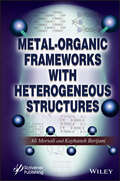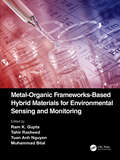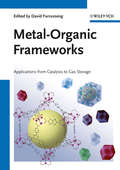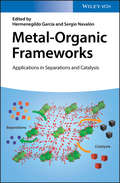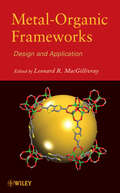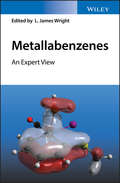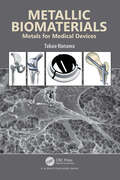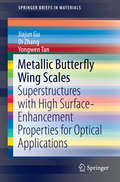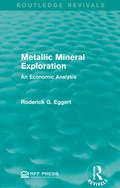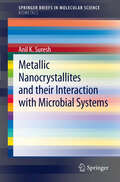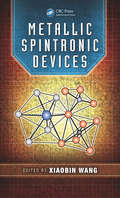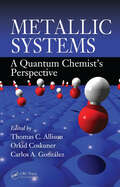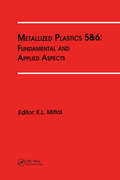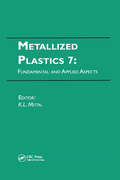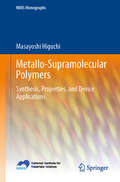- Table View
- List View
Metal-Organic Frameworks in Biomedical and Environmental Field
by Patricia Horcajada Cortés Sara Rojas MacíasThis book joins an international and interdisciplinary group of leading experts on the biomedical, energy and environmental applications of Metal-Organic Frameworks (MOFs). The resulting overview covers everything from the environmentally friendly and scale up synthesis of MOFs, their application in green energy generation and storage, and water purification to their use as drug delivery systems, biosensors, and their association with relevant macromolecules (genes, enzymes). This book is focused on the interest of MOFs in applications such as the leading –edge environmental (energy-related) and biomedical fields. The potential of MOFs in these areas is currently progressing at a fast pace, since the wide possibilities that MOFs offer in terms of composition, topology, incorporation of active species (in their porosity, on their external surface or within the framework), and post-synthetic modifications, among others. The aim here is to provide future research goals that emphasize relevant nuances to this class of materials as a whole.
Metal-Organic Frameworks with Heterogeneous Structures
by Ali Morsali Kayhaneh BerijaniFor the first time, in this book, a new view of metal-organic frameworks (MOFs) has been presented: MOFs with heterogeneous structures. In this field, there are different levels of understanding we need to consider. So, the principal aspects of heterogeneity that produce complexity in MOFs, their effects in the structure chemistry, performance and applications have been thoroughly reported. According to that there is no book that covers whole of the aspects of complexity in MOFs with heterogeneous structures, our findings can be as essential concepts with introducing complexity to design the new platforms of materials with advanced and better properties in the future.
Metal-Organic Frameworks-Based Hybrid Materials for Environmental Sensing and Monitoring
by Ram K. GuptaWith an unprecedented population boom and rapid industrial development, environmental pollution has become a severe problem for the ecosystem and public health. Classical techniques for sensing and determining environmental contaminants often require complex pretreatments, expensive equipment, and longer testing times. Therefore, new, and state-of-the-art sensing technologies possessing the advantages of excellent sensitivity, rapid detection, ease of use, and suitability for in situ, real-time, and continuous monitoring of environmental pollutants, are highly desirable. Metal-Organic Frameworks-based Hybrid Materials for Environmental Sensing and Monitoring covers the current-state-of-the-art hybrid nanomaterials based on metal-organic frameworks for electrochemical monitoring purposes. Accomplished authors cover various synthetic routes, methods, and theories behind enhancing the electrochemical properties and applications of metal-organic frameworks-based hybrid nanomaterials for electrochemical sensing of environmental pollutants under one roof. This book is essential reading for all academic and industrial researchers working in the fields of materials science and nanotechnology.
Metal-Organic Frameworks: Applications from Catalysis to Gas Storage
by David FarrussengAn international and interdisciplinary team of leading experts from both academia and industry report on the wide range of hot applications for MOFs, discussing both the advantages and limits of the material. The resulting overview covers everything from catalysis, H2 and CH4 storage and gas purification to drug delivery and sensors. From the Contents: - Design of Porous Coordination Polymers/Metal-Organic Frameworks: Past, Present and Future - Design of Functional Metal-Organic Frameworks by Post-Synthetic Modification - Thermodynamic Methods for Prediction of Gas Separation in Flexible Frameworks - Separation and purification of gases by MOFs - Opportunities for MOFs in CO2 capture from flue gases, natural gas and syngas by adsorption - Manufacture of MOF thin films on structured supports for separation and catalysis - Research status of Metal-Organic Frameworks for on-board cryo-adsorptive hydrogen storage applications - Separation of xylene isomers - Metal-Organic Frameworks as Catalysts for Organic Reactions - Biomedical applications of Metal Organic Frameworks - Metal Organic Frameworks for Biomedical Imaging - Luminescent Metal-Organic Frameworks - Deposition of thin films for sensor applications - Industrial MOF Synthesis - MOF shaping and immobilisation A must-have for every scientist in the field.
Metal-Organic Frameworks: Applications in Separations and Catalysis
by Hermenegildo García Sergio NavalónFocusing on applications in separation, adsorption and catalysis, this handbook underlines the importance of this hot and exciting topic. It provides an excellent insight into the synthesis and modification of MOFs, their synthesis on an industrial scale, their use as CO2 and chemical warfare adsorbers, and the role of defects in catalysis. In addition, the authors treat such new aspects as biocatalysis and applications in photocatalysis and optoelectronic devices.
Metal-Organic Frameworks: Design and Application (Eic Bks.)
by Leonard R. MacGillivrayMetal-organic frameworks represent a new class of materials that may solve the hydrogen storage problem associated with hydrogen-fueled vehicles. In this first definitive guide to metal-organic framework chemistry, author L. MacGillivray addresses state-of-art developments in this promising technology for alternative fuels. Providing professors, graduate and undergraduate students, structural chemists, physical chemists, and chemical engineers with a historical perspective, as well as the most up-to-date developments by leading experts, Metal-Organic Frameworks examines structure, symmetry, supramolecular chemistry, surface engineering, metal-organometallic frameworks, properties, and reactions.
Metal-Responsive Base Pair Switching of Ligand-type Uracil Nucleobases (Springer Theses)
by Keita MoriIn this thesis, the author proposes "metal-responsive base pair switching" of ligand-modified nucleobases as a novel tool for stimuli-responsive control of DNA assemblies. It is written to demonstrate broad applicability of the base pair switching in dynamic DNA nanotechnology and inspire researchers to use this technique. Based on specific interactions between ligand-type nucleobases and target metal ions, in this volume, DNA hybridization was dynamically controlled through strand displacement reactions. The base pair switching was further applied to develop metal-dependent DNA molecular machines. This novel strategy for stimuli-responsive regulation of DNA assemblies will greatly expand the scope of dynamic DNA nanotechnology. This volume uniquely features importance of elaborate molecular design based on chemistry for imparting stimuli responsiveness to DNA assemblies.
Metalation of Azines and Diazines
by Marko D. Mihovilovic Michael SchnürchReactions of Pyridines, Benzopyridines and Azapyridines with Organomagnesiums and Organolithiums, by Manfred Schlosser Lithiations and Magnesiations on Quinoline and Isoquinoline, by Floris Chevallier, Florence Mongin Metalation Reactions of Pyridines, Quinolines, and Isoquinolines with Ate Bases and Their Alkali Metal Salt-Modified Congeners, by Costa Metallinos, Kathryn Stromski Lithiations and Grignard Reactions on Pyrimidine and Quinazoline, by Andrej Kolarovic Other Stoichiometric Metalation Reactions on Pyrimidine and Quinazoline, by Philippe C. Gros Metalation of Pyrazine and Quinoxaline, by Nelly Plé1, Corinne Fruit Metalation of Pyridazine, Cinnoline, and Phtalazine, by Ernst Horkel
Metalation of Azoles and Related Five-Membered Ring Heterocycles
by Gordon W. GribbleT. L.S. Kishbaugh: Metalation of Pyrrole.- K.-S. Yeung: Furans and Benzofurans.- P. E. Alford: Lithiation-Based and Magnesation-Based Strategies for the Functionalization of Imidazole: 2001-2010.- L. Fu: Metalation of Oxazoles and Benzoxazoles.- S. Roy * S. Roy * G. W. Gribble: Metalation of Pyrazoles and Indazoles.- J. C. Badenock: Metalation Reactions of Isoxazoles and Benzisoxazoles.- Y.-J. Wu: Thiazoles and Benzothiazoles.- C. F. Nutaitis: Isothiazoles and Benzisothiazoles.- E. R. Biehl: Recent Advances in the Synthesis of Thiophenes and Benzothiophenes.- J. M. Lopchuk: Mesoionics.- J. M. Lopchuk: Azoles with 3-4 Heteroatoms.
Metallabenzenes: An Expert View
by L. James WrightThe only comprehensive book covering of advances in metallabenzene chemistry—written by the leading experts in the field Metallabenzenes: An Expert View provides comprehensive coverage of all aspects of metallabenzene chemistry, including syntheses, reactions, physical properties, and theoretical treatments of metallabenzenes. Fused ring metallabenzenes, heterometallabenzenes, and metallabenzenes that are p-bound to other metal fragments are also discussed in depth. Although benzene itself was discovered in 1825, it wasn’t until 1982 that the first metallabenzene was isolated. Since then, interest in these compounds has built steadily, and metallabenzene chemistry is now a flourishing sub discipline in its own right. A diverse range of synthetic approaches to these compounds have been devised, and new developments and discoveries have appeared regularly over the past several decades. Yet, until now, no books devoted to this fascinating and important class of chemical compounds have been available to researchers and students. This bookfills that gap in the literature with a comprehensive review of recent advances in metallabenzene chemistry theory and applications. Featuring contributions by an international group of experts in the field, each chapter summarizes important recent research in and significant contributions to various aspects of metallabenzene chemistry. Provides academics, researchers and graduate students with a comprehensive review of advances in metallabenzene research Covers fused-ring metallabenzenes—including metallanaphthalenes, metallabenzofurans, and metallabenzothiophenes—as well as p-bound heterometallabenzenes and metallabenzenes Reviews the latest computational studies that have led to the theoretical understanding of metallabenzenes Includes critical discussions of metallabenzene aromaticity, an area rarely covered by computational experts Metallabenzenes: An Expert View is an important working resource for those working in organometallic chemistry, aromaticity, coordination chemistry, theoretical chemistry, catalysis and materials science. It is also an excellent text for graduate-level courses in those areas.
Metallic Biomaterials: Metals for Medical Devices
by Takao HanawaMetallic materials are used in many medical devices due to their high mechanical reliability and their excellent strength and toughness. They account for more than 70% of internally implantable devices (implants). This book helps understand the necessity and problems of metal materials used in medical applications. This book was written with the goal of helping students learn the essentials of metallic biomaterials and acquire knowledge that can be applied in a progressive manner. The target audience for this book are students, graduate students, engineers, medical doctors, and others who need knowledge about metallic biomaterials.
Metallic Butterfly Wing Scales
by Jiajun Gu Di Zhang Yongwen TanThis book presents a method for replicating natural butterfly wing scales using a variety of metals for state-of-the-art applications requiring high surface-enhancement properties. During the past decade, three dimensional (3D) sub-micrometer structures have attracted considerable attention for optical applications. These 3D subwavelength metallic structures are, however, difficult to prepare. By contrast, the 3D superstructures of butterfly wing scales, with more than 175 000 morphologies, are efficiently engineered by nature. Natural butterfly wing scales feature 3D sub-micrometer structures that are superior to many human designs in terms of structural complexity, reproducibility, and cost. Such natural wealth offers a versatile chemical route via the replication of these structures into functional metals. A single versatile chemical route can be used to produce butterfly scales in seven different metals. These synthesized structures have the potential for catalytic (Au, Pt, Pd), thermal (Ag, Au, Cu), electrical (Au, Cu, Ag), magnetic (Co, Ni), and optical (Au, Ag, Cu) applications. Plasmon-active Au, Cu, Ag butterfly scales have exhibited excellent properties in surface-enhanced Raman scattering (SERS). The Au scales as SERS substrates have ten times the analyte detection sensitivity and are one-tenth the cost of their human-designed commercial counterparts (KlariteTM). Preliminary mechanisms of these surface-enhancement phenomena are also reviewed.
Metallic Glass-Based Nanocomposites: Molecular Dynamics Study of Properties
by Sumit SharmaMetallic Glass-Based Nanocomposites: Molecular Dynamics Study of Properties provides readers with an overview of the most commonly used tools for MD simulation of metallic glass composites and provides all the basic steps necessary for simulating any material on Materials Studio. After reading this book, readers will be able to model their own problems on this tool for predicting the properties of metallic glass composites. This book provides an introduction to metallic glasses with definitions and classifications, provides detailed explanations of various types of composites, reinforcements and matrices, and explores the basic mechanisms of reinforcement-MG interaction during mechanical loading. It explains various models for calculating the thermal conductivity of metallic glass composites and provides examples of molecular dynamics simulations. Aimed at students and researchers, this book caters to the needs of those working in the field of molecular dynamics (MD) simulation of metallic glass composites.
Metallic Micro and Nano Materials
by Masumi SakaThis book focuses on the metallic Nano- and Micro-materials (NMMs) fabricated by physical techniques such as atomic diffusion. A new technology for fabricating NMMs by atomic diffusion is presented. Two kinds of atomic diffusion are treated; one is a phenomenon caused by electron flow in high density and called electromigration and the other is stress migration which depends on a gradient of hydrostatic stress in a material. In three parts, the book describes the theory of atomic diffusion, the evaluation of physical properties and the treatment and applications of metallic NNMS. The new methods such as atomic diffusion are expected are expected to be crucial for the fabrication of NNMs in the future and to partially replace methods based on chemical reactions.
Metallic Mineral Exploration: An Economic Analysis (Routledge Revivals)
by Roderick G. EggertHow has exploration for minerals evolved in recent years? Is it as productive an activity as it once was? Why have changes occurred? Roderick G. Eggert explores these and other questions about the complex set of circumstances surrounding metallic mineral exploration. Originally published in 1987, Eggert documents trends in the level and the distribution of expenditures by mining companies for metallic mineral exploration and examines a number of factors that may be responsible for these trends. This significant study serves as a handy introduction to the subject for students interested in environmental studies, natural resources, and economics.
Metallic Nanocrystallites and their Interaction with Microbial Systems
by Anil K. SureshAlthough interactions between nanoparticles and microorganisms in the environment are unavoidable and commonplace, it is still not clear what potential effects they may have. Metallic Nanocrystallites and their Interface with Microbial Systems not only illustrates how microbes and these particular nanoparticles interact but also it describes the consequences of these interactions. This brief discusses the impact of gold, silver, zinc oxide, and cerium oxide nanoparticles on the growth and viability of both Gram-negative and Gram-positive bacterium. Moreover, it analyses the relationship between bacterial growth inhibition, reactive oxygen species generation, the regulation of transcriptional stress genomes, and the toxicity of these materials. Finally, it reviews the specific metallic nanomaterials and highlights their modes of synthesis, reactivity at surfaces, and the importance of assay procedures in determining their toxicity levels. Various microscopy techniques used to determine their mechanisms of action are also presented. Metallic Nanocrystallites and their Interface with Microbial Systems will be a valuable source to the scientific and industrial community as well as to students and researchers in microbiology, biotechnology, nanotechnology, toxicology, materials science, biomedical engineering, cell and molecular biology.
Metallic Nanoparticles for Health and the Environment (Advances in Bionanotechnology)
by Md Sabir Alam Md Noushad Javed Jamilur R. AnsariMetallic Nanoparticles for Health and the Environment covers different routes of synthesis for metallic nanoparticles and their process variables. Both the functions and roles of these particles as a drug delivery system and diagnostic agent and other potential theranostic purposes against metabolic disorders, photocatalysis applications, as well as wastewater treatments, are discussed. The book compares the different properties of bulk metallic forms and their nanoparticulated forms. It discusses the mechanisms and impacts of different process variables in different synthesis routes, as well as emerging trends in clinics and so forth. Features: Covers different routes of synthesis to create metallic nanoparticles (MNPs) of different characteristics with reference to bulk forms of metals. Describes formulation parameters that have a significant effect on these MNPs including dimensions, morphology, mechanism, surface properties, and other characteristics. Discusses different roles and performances of MNPs in photothermal therapy, metabolic disorders, mechanisms in bacterial, fungal, and viral infections, and inflammatory pathways. Reviews the potential and emerging roles of different MNPs with site target delivery applications and genetic manipulation purposes. Examines the advantages and challenges of these MNPs against remediation of pollutants and toxicants, owing to their superior surface catalytic activities. This book is aimed at researchers and professionals in nanomaterials, pharmaceuticals, and drug delivery.
Metallic Powders for Additive Manufacturing: Science and Applications
by James F. Shackelford Kaka Ma Enrique J. Lavernia Julie M. Schoenung Baolong ZhengMetallic Powders for Additive Manufacturing Overview of successful pathways for producing metal powders for additive manufacturing of high-performance metallic parts and components with tailored properties Metallic Powders for Additive Manufacturing introduces the readers to the science and technology of atomized metal powders beyond empirical knowledge and the fundamental relationships among the chemistry, microstructure, and morphology of atomized metallic powders and their behavior during additive manufacturing. The text sets a foundation of the underlying science that controls the formation and microstructure of atomized metallic droplets, including the relations among the properties of metallic powders, their performance during the manufacturing processes, and the resulting products. Other topics covered include the influence of powder on defect formation, residual stress, mechanical behavior, and physical properties. The concluding two chapters encompass considerations of broader societal implications and overarching themes, including the exploration of alternative feedstock materials, economic analysis, and sustainability assessment. These chapters offer valuable perspectives on the prospective trajectory of the field. Written by a team of experienced and highly qualified professors and academics, Metallic Powders for Additive Manufacturing includes information on: Atomization techniques such as Vacuum Induction Gas Atomization (VIGA), Electrode Induction Melting Gas Atomization (EIMGA), and Plasma Rotating Electrode Process (PREP) Atomization science and technology, covering control of atomization parameters, powder size distribution, effect of processing variables, and theoretical models of atomization Heat transfer and solidification of droplets, covering nucleation, microstructure development, and important thermal and solidification conditions during atomization Atomization of Al, Fe, Ni, Co, Ti, and high entropy alloys, as well as composite powders for additive manufacturing, and guidelines for atomization equipment and powder handling Fundamental processing principles in a variety of metal additive manufacturing processes Powder characteristics and requirements for different additive manufacturing processes Effect of powder chemistry and physical characteristics on additive manufacturing processes, and the microstructure and properties of the built parts Evaluation of alternative feedstock sources for metal additive manufacturing, beyond gas atomized powder Economic and sustainability perspectives on powder production and additive manufacturing Metallic Powders for Additive Manufacturing is an excellent combination of rigorous fundamentals and a practice-oriented and forward-looking resource on the subject for materials scientists and practicing engineers seeking to understand, optimize, and further develop the field of powder production and additive manufacturing.
Metallic Spintronic Devices (Devices, Circuits, and Systems #32)
by Krzysztof Iniewski Xiaobin WangMetallic Spintronic Devices provides a balanced view of the present state of the art of metallic spintronic devices, addressing both mainstream and emerging applications from magnetic tunneling junction sensors and spin torque oscillators to spin torque memory and logic. Featuring contributions from well-known and respected industrial and academic experts, this cutting-edge work not only presents the latest research and developments but also: Describes spintronic applications in current and future magnetic recording devices Discusses spin-transfer torque magnetoresistive random-access memory (STT-MRAM) device architectures and modeling Explores prospects of STT-MRAM scaling, such as detailed multilevel cell structure analysis Investigates spintronic device write and read optimization in light of spintronic memristive effects Considers spintronic research directions based on yttrium iron garnet thin films, including spin pumping, magnetic proximity, spin hall, and spin Seebeck effects Proposes unique solutions for low-power spintronic device applications where memory is closely integrated with logic Metallic Spintronic Devices aims to equip anyone who is serious about metallic spintronic devices with up-to-date design, modeling, and processing knowledge. It can be used either by an expert in the field or a graduate student in course curriculum.
Metallic Systems: A Quantum Chemist's Perspective
by Thomas C. Allison Orkid Coskuner Carlos A. GonzálezMetallic systems are ubiquitous in daily life. They play key roles, for example, in the chemistry of many biomolecules, ionic solutions, nanoparticles, and catalytic processes. They may be in solid, liquid, or gaseous form. The interactions of other molecules with metal surfaces are of considerable importance. Each of these topics is addressed in M
Metallized Plastics 5&6: Fundamental and Applied Aspects
by K. L. MittalThis book chronicles the proceedings of the 5th and 6th symposia on Metallized Plastics: Fundamental and Applied Aspects, held in May 1996 and September 1997 respectively. This volume contains 29, carefully reviewed, revised and up-dated papers which were presented at both symposia. The book is divided in the following three parts: Metallization Te
Metallized Plastics 7: Fundamental and Applied Aspects
by K. L. MittalThis volume documents the proceedings of the 7th Symposium on Metallized Plastics: Fundamental and Applied Aspects, held in Newark, New Jersey, December 2-3, 1999. This volume contains a total of 16 papers, which were all rigorously peer reviewed and suitably revised before inclusion. The book is divided into two parts: Metallization Techniques and Properties of Metal Deposits, and Interfacial and Adhesion Aspects. The topics covered include: various metallization techniques for a variety of plastics including some novel developments involving suitable plastic pretreatments; modification of polymers by plasma and ion-assisted reactions; metal doped plasma polymer films; metal-polyimide nanocomposite films; investigation of metal/polymer interactions by a variety of techniques; ways to improve adhesion of metal/polymer systems; modeling of metal/polymer interfaces; application of surface analytical techniques in the arena of metallized plastics; and ultrathin films on metal surfaces. This volume offers a wealth of information and represents current commentary on the R&D activity taking place in the technologically highly important field of metallized plastics and is of value and interest to anyone interested in the fundamental or applied aspects of metallized plastics.
Metallized and Magnetic Polymers
by Johannes Karl FinkThis book focuses on the chemistry of metallized and magnetic polymers, as well as the special applications of these materials. After an introductory section on the general aspects of the field, the types and uses of these polymers are detailed, followed by an overview of the testing methods. The book is divided equally into two parts - metallized polymers and magnetic polymers - and both parts follow the same structure: All methods of fabrication Properties and methods of measurement including standard test methods and interface properties Fields of applications Environmental issues including recycling and biodegradable polymers
Metallo-Supramolecular Polymers: Synthesis, Properties, and Device Applications (NIMS Monographs)
by Masayoshi HiguchiThis book introduces the synthesis, electrochemical and photochemical properties, and device applications of metallo-supramolecular polymers, new kinds of polymers synthesized by the complexation of metal ions and organic ditopic ligands. Their electrochemical and photochemical properties are also interesting and much different from conventional organic polymers. The properties come from the electronic intra-chain interaction between the metal ions and the ligands in the polymer chain. In this book, for example, the electrochromism that the Fe(II)-based metallo-supramolecular polymer exhibits is described: the blue color of the polymer film disappears by the electrochemical oxidation of Fe(II) ions to Fe(III) and the colorless film becomes blue again by the electrochemical reduction of Fe(III) to Fe(II). The electrochromism is explained by the disappearance/appearance of the metal-to-ligand charge transfer absorption. The electrochromic properties are applicable to display devices such as electronic paper and smart windows.
Metallocenes in Regio- and Stereoselective Synthesis (Topics in Organometallic Chemistry #74)
by Marko Hapke Martin KotoraThis book presents the latest synthetic protocols for the assembly of functionalized Cp ligands and their transition metal complexes. Cyclopentadienyl (Cp) complexes of transition metals belong to the most important classes of transition metal complexes with tightly bound ligands in the coordination sphere since their discovery in the middle of the last century. Even though they have been known for a long time, this field constantly evolves to deliver novel modified Cp ligands and complexes and to blossom into new fields of application. Beside the synthesis of ligands and metal complexes this book concentrates on novel and prospering fields of their application in organic synthesis. In this respect the Cp complexes have been applied to induce and catalyze various significant chemical transformations such as new C-C bond formation involving unsaturated substrates (e.g. cyclotrimerizations, cycloadditions, carbometallations, etc.), C-H bond and C-C bond activations followed by subsequent reactions (e.g. arylation, alkenylations, annulations, etc.), as well as many other processes. This volume also covers the recent development and application of chiral Cp complexes in enantioselective synthesis.

